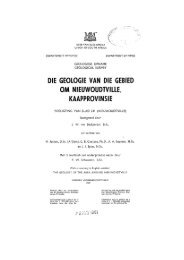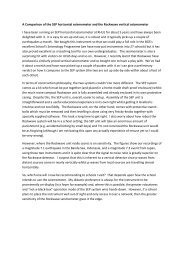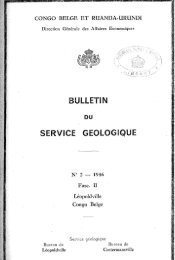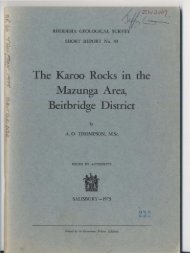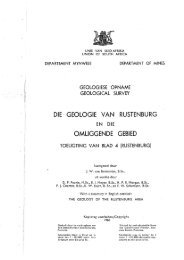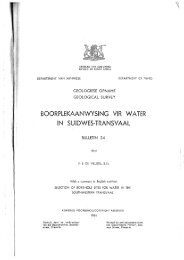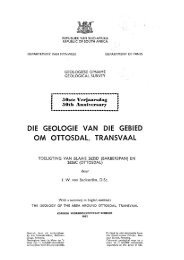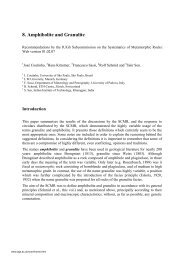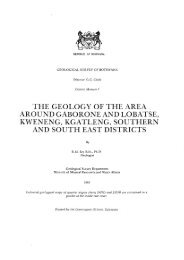Bibliography - British Geological Survey
Bibliography - British Geological Survey
Bibliography - British Geological Survey
You also want an ePaper? Increase the reach of your titles
YUMPU automatically turns print PDFs into web optimized ePapers that Google loves.
1915 to Elephas. Osborn considers Eoanthropus dawsoni to be contemporary with Archidiskodon and thus<br />
of Upper Pliocene age. A letter from A. T. Hopwood, dated 4 June 1928, likewise expresses an inclination to<br />
put the Piltdown skull ‘with the older fauna, and the Eolithic culture.’ Page 968, fig. 856, presents a ‘Scene<br />
on the ancient River Ouse illustrating the Osborn theory of the Upper Pliocene age of Eoanthropus dawsoni /<br />
Restoration by Margret Flinsch in 1934, under the direction of Henry Fairfield Osborn.’ This scene depicts<br />
Piltdown Man wielding the bone ‘implement’, while on the left bank of the river we see Archidiskodon<br />
planifrons, together with the straight-tusked mastodon, Anancus arvernensis, and on the right bank, a herd of<br />
Equus stenonsis.)<br />
Osborn, H. F. & Gregory, W. K. 1923. The Dawn Man [: an authorised interview.] McClure’s Magazine<br />
(New York), 55 (1), 19–28.<br />
Padgham, F. (see Anon. 1954a)<br />
Paine, C. 2013. Mystery of the two martyrs: where are the firebacks now? Sussex Past & Present, no. 130<br />
(Aug), 6–7. (The Sussex Archaeological Society possesses a cast-iron fireback known as ‘The Sussex Martyrs<br />
fireback’, on the back of which is inscribed ‘Sussex Martyrs / Burwash / cast August 1908 / Charles Dawson<br />
FSA’. It is said to be one of three replicas made to the order of Henry Willett, who died Feb 1905 (not 1903<br />
as here stated). Nothing is known regarding the present whereabouts either of the other two copies or the<br />
original. One copy appears to have been in the possession of Hastings Museum, though only in the form of a<br />
plaster cast, and is now lost. A fireback like this was recorded at Brick House, Burwash in 1871, and the<br />
replicas may have been made at the Burwash forge. A rather poor photograph of the fireback features in<br />
Dawson 1903, plate 8e, and is stated to be from Dawson’s collection, but seems to differ slightly, possibly<br />
because of retouching, from the example illustrated in the present paper. We are thus presented with a mystery<br />
as to whether the inscribed date of ‘August 1908’, which has been confirmed by this compiler, is an error on<br />
Dawson’s part, or indicates a later casting!)<br />
Pallister, D. 1978. Professional pique and the Piltdown Man. Guardian, 30 Oct, 3. (A report, with some<br />
additional details, of Halstead’s presentation of James Douglas’s ‘evidence’ implicating W. J. Sollas as coconspirator<br />
with Dawson in the Piltdown fraud. See also Holliday & Williams 1978, & Parker 1978)<br />
Parker, R. 1978. Professor names his predecessor as Piltdown Man hoaxer. The Times, 30 Oct, 2. (<br />
Peacock, D. P. S. 1973. Forged brick-stamps from Pevensey. Antiquity, 47, no. 186, 138‒140. (Detailed<br />
scientific examination of the brick-stamps supposedly dating from the time of the Roman emperor Honorius,<br />
AD 395‒423, and stated by Dawson to have been discovered on the site of the Roman fort of Pevensey,<br />
shows them to be early 20th-century forgeries. See Dawson 1907.)<br />
Perrin, P. & Coleman, W. 2004. The mystery of the Piltdown skull. Logan, Iowa: Perfection Learning,<br />
64 pp. (This work is evidently aimed at a young audience)<br />
Pettitt, J. 1975. No absolution. Sussex Archaeological Society Newsletter, no. 15 (Mar), 67. (An analysis<br />
of the ‘Maresfield Forge’ map, which is credited to Dawson, has yielded ‘the impossible, the ‘never-was’<br />
and three major anachronisms.’ A number of these discrepancies are described. The author claims to have a<br />
longer, referenced article with maps and grid references; he was possibly unaware of Andrews 1974.)<br />
Pigliucci, M. 2005. Piltdown and how science really works. Skeptical Inquirer, 29 (1), 20–21. (Response<br />
by Shaw 2005)<br />
Pilgrim, G. E. 1915. New Siwalik primates and their bearing on the question of the evolution of Man and<br />
the Anthropoidea. Records of the <strong>Geological</strong> <strong>Survey</strong> of India, 45 (1), 1‒74, plates I-IV. (Concludes from<br />
comparative studies that ‘Eoanthropus represents a collateral stem which did not lead to Man as we know<br />
him from any of the recent and most of the fossil types, being, so to speak, only one of Nature’s experiments<br />
at producing the higher human types.’ See pp. 38, 51‒52, 57‒60.)<br />
Pitts, M. 2004. Piltdown: time to stop the slurs. <strong>British</strong> Archaeology, no. 74 (Jan), 8–12. (Includes edited<br />
extracts from the Sussex Express & County Herald, Nov and Dec 1954. Issue no. 75 of <strong>British</strong> Archaeology<br />
carried reactions from G. Mullan, D. Padgham and M. Russell, under the heading X-filed fossils.)<br />
Place, M. 1994. Piltdown Man and batwoman. Huddersfield: The Word Hoard. (Volume of poetry)<br />
Pontier, G. 1925. Etude sur l’Elephas planifrons (Falconer) du Pliocène supérieur d’Angleterre. Annales de<br />
la Société Géologique du Nord, 48, 153–159, plate II. (A discussion of the occurrence of Elephas planifrons



